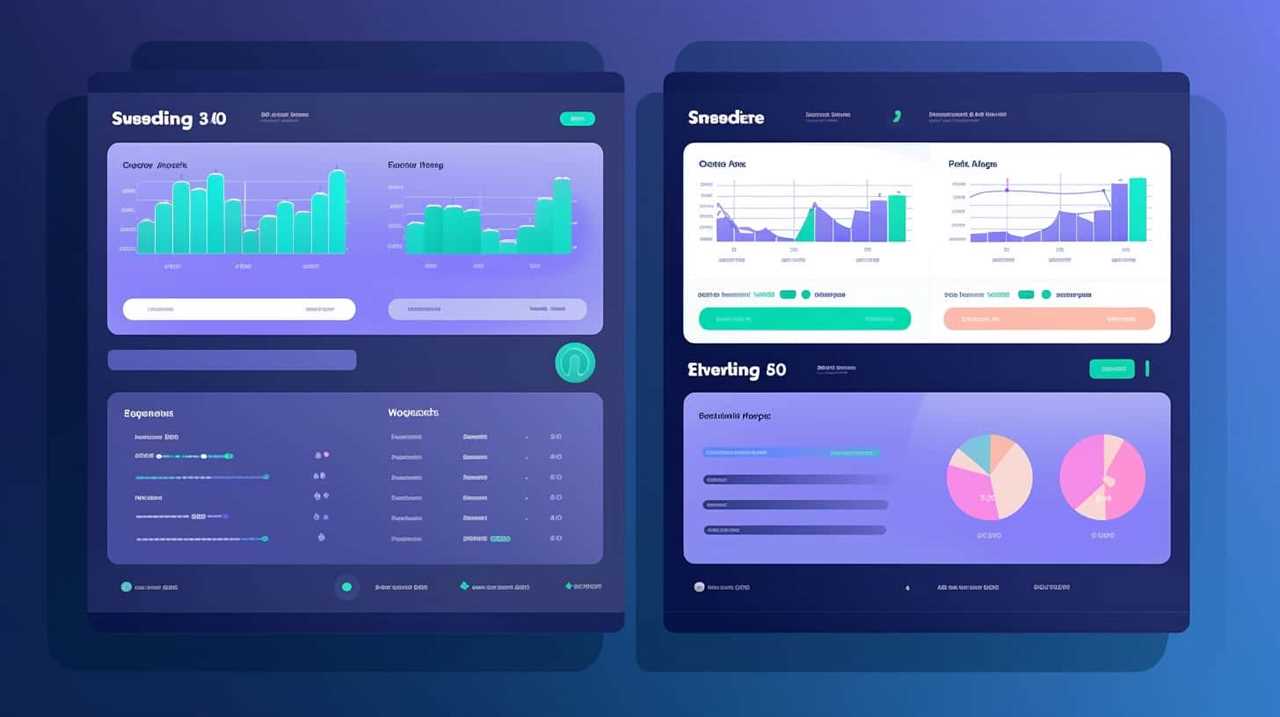Many of us have been in the position of figuring out which keywords will boost our website to the top of search engine results. This task may appear overwhelming, but fear not!
In this article, we’ll dive deep into the world of SEO keywords. We’ll explore their importance, types, and how to choose the most effective ones.
With examples of successful strategies and tips on implementation and monitoring, you’ll soon master the art of SEO keywords.
Let’s get started!

Key Takeaways
- SEO keywords are crucial for improving website visibility and driving organic traffic.
- Long tail keywords target a narrower audience and have less competition, increasing the chances of ranking higher in search engine results.
- Striking the right balance between keyword usage and content quality is key to optimizing for search engines.
- Researching and analyzing keyword data is crucial for choosing effective SEO keywords.
Importance of SEO Keywords
The importance of SEO keywords can’t be overstated as they play a crucial role in improving our website’s visibility and driving organic traffic.
One aspect to consider is the importance of long tail keywords. These are longer and more specific keyword phrases that target a narrower audience, but have less competition. By incorporating long tail keywords into our content, we can attract highly targeted traffic and increase our chances of ranking higher in search engine results.
Another factor to consider is the role of keyword density in SEO. Keyword density refers to the percentage of times a keyword appears in relation to the total number of words on a webpage. While it’s important to include keywords strategically, it’s equally important to avoid overstuffing them, as this can negatively impact our website’s ranking.
Striking the right balance is key to optimizing our content for search engines while providing valuable and relevant information to our audience.

Definition of SEO Keywords
Now let’s define SEO keywords and understand their importance in optimizing our website’s visibility.
SEO keywords are specific words or phrases that users enter into search engines when looking for information or products.
Importance of SEO Keywords
Understanding the significance of SEO keywords is essential for optimizing website content and improving search engine rankings. One important aspect to consider is the importance of long tail keywords. These are specific and targeted phrases that can attract a more qualified and interested audience to your website. By incorporating long tail keywords into your content, you increase the chances of your website appearing in relevant search results.
Another factor to consider is the impact of keyword density on SEO rankings. Keyword density refers to the number of times a keyword appears in relation to the total number of words on a page. While it’s important to include keywords in your content, it’s equally important to maintain a natural and organic flow. Overloading your content with keywords can lead to keyword stuffing, which can negatively affect your search engine rankings.

Striking the right balance is crucial for effective SEO keyword optimization.
Types of SEO Keywords
There are various categories of SEO keywords that play a crucial role in optimizing website content and improving search engine rankings. One type of SEO keyword is the long tail keyword, which is a more specific and targeted phrase that helps attract a highly relevant audience. These keywords are longer and more specific, allowing businesses to rank higher for niche searches.
Another important factor to consider is keyword density, which refers to the number of times a keyword appears in a piece of content relative to the total word count. By maintaining an optimal keyword density, websites can improve their visibility on search engines.
Understanding the different types and uses of SEO keywords is essential for effective optimization strategies. Now, let’s delve into the various types of SEO keywords.

Types of SEO Keywords
We frequently use various types of SEO keywords to optimize our website and improve its search engine rankings. When it comes to SEO, there are different types of keywords that play a crucial role in on-page optimization. These include:
- Short Tail Keywords: These are generic, one to two-word phrases that have a high search volume but also high competition. They’re essential for targeting a broad audience.
- Long Tail Keywords: These are longer and more specific keyword phrases that target a narrower audience. They’ve lower search volume but higher conversion rates, making them valuable for driving targeted traffic.
In the next section, we’ll discuss how to choose effective SEO keywords to maximize our website’s visibility and attract the right audience.
How to Choose Effective SEO Keywords
To effectively choose SEO keywords, we can continue the discussion by focusing on the process of researching and analyzing keyword data.
One effective strategy is finding long tail keywords for better SEO rankings. These are longer and more specific keyword phrases that target a specific audience and have less competition. By incorporating long tail keywords into your content, you can increase the chances of your website ranking higher in search engine results.

Another strategy is using competitor analysis to discover high performing keywords. By analyzing the keywords that your competitors are targeting, you can gain valuable insights into what’s working well in your industry and identify opportunities to improve your own keyword strategy.
In the next section, we’ll explore various keyword research tools and techniques that can further enhance your SEO keyword selection process.
Keyword Research Tools and Techniques
Effective keyword research is essential for successful SEO campaigns. It allows us to identify the most relevant and competitive keywords that will drive organic traffic to our website.
To conduct keyword research effectively, we can use various tools and techniques. Some popular keyword research tools include Google Keyword Planner, SEMrush, and Ahrefs. These tools provide valuable insights into keyword search volume, competition, and trends.

Additionally, we can employ the following techniques to analyze keyword competition:
- Use long-tail keywords: These are more specific and have lower competition, making it easier to rank for them.
- Analyze competitor keywords: By studying the keywords used by our competitors, we can gain insights into their SEO strategies and identify untapped opportunities.
Examples of Successful SEO Keyword Strategies
Utilizing the insights gained from keyword research tools and competitor analysis, we can implement successful SEO keyword strategies to improve our website’s visibility and search engine rankings.
When it comes to developing successful SEO keyword strategies, it’s important to follow the best practices for SEO keyword research. This includes identifying relevant keywords that have high search volume and low competition, as well as incorporating long-tail keywords that are specific to our target audience.
Additionally, we should prioritize optimizing our website’s content by strategically placing keywords in the title tags, meta descriptions, headers, and throughout the body of the content.

By implementing these successful SEO keyword strategies, we can increase our website’s organic traffic and attract more qualified leads.
Now, let’s explore how to implement these SEO keywords on our website.
Implementing SEO Keywords on Your Website
When it comes to implementing SEO keywords on our website, there are a few key points to keep in mind.
First, effective keyword research is crucial in identifying the right keywords to target.

Next, we need to optimize our website content by strategically incorporating these keywords in our titles, headings, and body text.
Lastly, it’s important to constantly monitor the performance of our keywords and make necessary adjustments to ensure maximum visibility and ranking on search engine result pages.
Effective Keyword Research
To optimize our website for search engines, we implement SEO keywords through effective keyword research. This entails conducting an in-depth analysis to identify relevant keywords that align with our website’s content and target audience. Here’s how we approach effective keyword research:
- Step 1: Effective Keyword Analysis
- We begin by analyzing the current keywords used on our website and identifying any gaps or areas for improvement.
- We also assess the competitiveness of these keywords and explore opportunities to target less competitive but highly relevant keywords.
- Step 2: Finding Relevant Keywords
- We conduct thorough research using keyword research tools to identify keywords that are frequently searched for by our target audience.
- Additionally, we consider long-tail keywords and variations that can help us capture more specific search queries.
Optimizing Content With Keywords
Continuing our discussion on effective keyword research, we optimize our website’s content by implementing SEO keywords to improve visibility and attract the right audience.

Optimizing SEO content involves strategically incorporating relevant keywords throughout the website’s pages, blog posts, and other content. This helps search engines understand the context of our website and rank it higher in search results.
However, it’s important to maintain a balance and avoid overusing keywords, which can negatively impact user experience and lead to keyword stuffing penalties from search engines.
To ensure keyword optimization, we can conduct keyword density analysis to determine the optimal frequency of keywords in our content.
By implementing SEO keywords effectively, we can enhance our website’s visibility and attract the right audience.

Moving forward, let’s explore how to monitor keyword performance and make necessary adjustments.
Monitoring Keyword Performance
As we implement SEO keywords on our website, we can effectively monitor keyword performance. This allows us to track our progress and analyze our competition in order to optimize our SEO strategy.
Here are two key ways to monitor keyword performance:
- Track Progress: Utilize tools like Google Analytics or SEO software to monitor keyword rankings and website traffic. Regularly analyze the data to identify trends and make data-driven decisions to improve our SEO performance.
- Analyze Competition: Conduct competitor analysis to understand what keywords our competitors are ranking for and how they’re performing. This helps us identify potential gaps or opportunities in our own keyword strategy and adjust accordingly.
Monitoring and Adjusting SEO Keywords for Optimal Results
We actively monitor and adjust our SEO keywords to achieve optimal results. Monitoring keyword rankings and adjusting keyword density are essential strategies for maintaining a high-performing website. By regularly tracking the performance of our keywords, we can identify trends, discover new opportunities, and make informed decisions to improve our website’s visibility and organic traffic. Additionally, adjusting keyword density ensures that our content remains relevant and valuable to both search engines and users. To showcase the importance of monitoring and adjusting SEO keywords, we have created a table that highlights key metrics and actions taken:

| Metric | Action | Result |
|---|---|---|
| Keyword rankings | Analyze top-performing keywords | Identify opportunities |
| Organic traffic | Optimize meta tags and content | Increase website visibility |
| Bounce rate | Improve page loading speed | Enhance user experience |
| Conversion rate | Conduct A/B testing | Optimize conversion funnel |
Continuously monitoring and adjusting our SEO keywords allows us to stay ahead of the competition and continuously improve our website’s performance.
Frequently Asked Questions
How Long Does It Take to See Results From Implementing SEO Keywords on a Website?
We track the progress of SEO keyword implementation on our website by monitoring rankings and organic traffic. To optimize for faster results, we focus on effective strategies like keyword research, on-page optimization, and building quality backlinks.
Can I Use the Same Keywords for Multiple Pages on My Website?
Yes, you can use the same keywords for multiple pages on your website. However, it’s crucial to choose the most effective keywords for each page to maximize SEO results. Avoid using keywords from your competitor’s website.
What Is the Difference Between Short-Tail and Long-Tail Keywords?
Short-tail and long-tail keywords have different levels of effectiveness. When optimizing website content, it’s crucial to choose the right keywords for your target audience. We’ll explain how to do this successfully.

Are There Any Specific Guidelines for Using Keywords in Meta Tags?
When it comes to optimizing meta tags with keywords, we follow the best practices. We also keep in mind the common mistakes to avoid. It’s important to ensure that our meta tags are strategically optimized for maximum impact.
Should I Prioritize Using Popular Keywords or Less Competitive Ones for Better SEO Results?
To achieve better SEO results, we should consider both popular and less competitive keywords. The pros and cons of using niche keywords versus broad keywords are significant, as is the impact of keyword placement on search engine rankings.
Conclusion
In the vast ocean of the internet, SEO keywords are like shining beacons guiding visitors to your website. They’re the secret sauce that unlocks the door to success.
Just like a skilled fisherman casting a net in the right spot, choosing effective SEO keywords is essential for reeling in your target audience.

With the right tools and techniques, you can navigate this digital landscape and watch your website soar to new heights.
So dive in, embrace the power of SEO keywords, and watch your online presence flourish.










